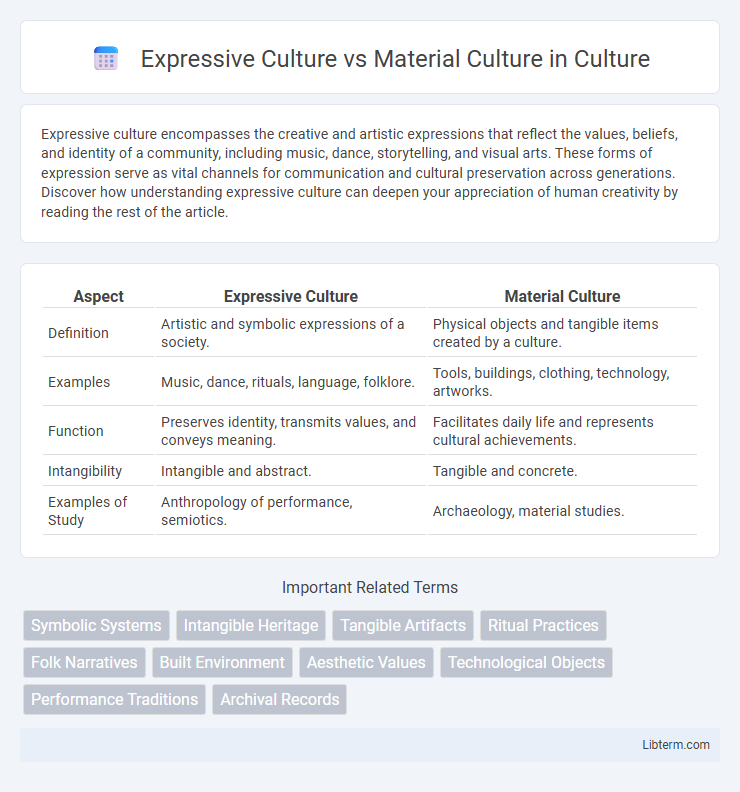Expressive culture encompasses the creative and artistic expressions that reflect the values, beliefs, and identity of a community, including music, dance, storytelling, and visual arts. These forms of expression serve as vital channels for communication and cultural preservation across generations. Discover how understanding expressive culture can deepen your appreciation of human creativity by reading the rest of the article.
Table of Comparison
| Aspect | Expressive Culture | Material Culture |
|---|---|---|
| Definition | Artistic and symbolic expressions of a society. | Physical objects and tangible items created by a culture. |
| Examples | Music, dance, rituals, language, folklore. | Tools, buildings, clothing, technology, artworks. |
| Function | Preserves identity, transmits values, and conveys meaning. | Facilitates daily life and represents cultural achievements. |
| Intangibility | Intangible and abstract. | Tangible and concrete. |
| Examples of Study | Anthropology of performance, semiotics. | Archaeology, material studies. |
Defining Expressive Culture
Expressive culture encompasses the intangible aspects of culture such as language, music, dance, rituals, and art forms that convey emotions, values, and beliefs within a society. It contrasts with material culture, which includes physical objects and artifacts like tools, clothing, and architecture. Defining expressive culture involves understanding how symbolic communication and creative expressions shape social identity and cultural continuity.
Understanding Material Culture
Material culture encompasses the physical objects, resources, and spaces that people use to define their culture, including tools, buildings, artworks, and clothing. Understanding material culture reveals insights into societal values, technological development, economic systems, and historical contexts by analyzing artifacts and their production methods. This tangible aspect of culture provides concrete evidence of human behavior and social organization across different civilizations.
Key Differences Between Expressive and Material Culture
Expressive culture refers to intangible elements such as art, music, language, and rituals that convey a community's values, beliefs, and emotions, whereas material culture includes physical objects like tools, clothing, buildings, and technology used by a society. The key difference lies in expressiveness being symbolic and experiential, representing non-material aspects of culture, while material culture embodies tangible artifacts that influence daily life and social practices. Understanding these distinctions highlights how expressive culture shapes identity and social cohesion, while material culture reflects economic conditions and technological advancement.
Historical Evolution of Expressive and Material Culture
Expressive culture, encompassing language, rituals, and artistic expressions, has evolved historically through the transmission of symbols and meanings across generations, shaping social identity and values. Material culture, involving physical objects like tools, architecture, and clothing, reflects technological advancements and economic conditions throughout history, serving as tangible evidence of human adaptation and cultural development. The interplay between expressive and material culture illustrates the dynamic process of cultural change, where innovations in material artifacts influence expressive forms and vice versa.
Role of Art and Symbolism in Expressive Culture
Art and symbolism serve as core components of expressive culture, conveying values, beliefs, and social meanings beyond physical objects. Expressive culture includes intangible elements such as rituals, language, music, and visual arts that reflect collective identity and emotional expression. Symbolism in art provides a shared framework for communities to interpret experiences, reinforcing cultural cohesion and continuity through metaphorical and representational forms.
Impact of Technology on Material Culture
Technology significantly shapes material culture by transforming the production, design, and distribution of physical objects, such as smartphones, wearable devices, and smart home systems. Innovations in manufacturing processes, like 3D printing and automation, enable rapid prototyping and mass production, altering consumer behavior and economic structures. This technological evolution not only redefines the utility and aesthetics of material artifacts but also influences societal values and cultural practices surrounding their use.
Cross-Cultural Perspectives on Expression and Materiality
Expressive culture, encompassing art, music, rituals, and language, reflects the symbolic and emotional aspects of diverse societies, while material culture includes the tangible objects and artifacts that people create and use. Cross-cultural perspectives reveal how expressions such as storytelling and dance convey identity and values uniquely in different communities, whereas material culture like tools, clothing, and architecture demonstrate adaptation to environment and technology. These dimensions interact dynamically, shaping cultural meaning and continuity across global societies through distinct yet interconnected modes of human creativity.
Influence on Identity and Social Structures
Expressive culture, including language, rituals, and art, shapes collective identity by fostering shared beliefs and emotional connections within communities. Material culture, such as tools, architecture, and technology, influences social structures by determining resource distribution, economic roles, and status symbols. Together, these cultural dimensions interact to define group cohesion and power dynamics in societies.
Intersections: When Expressive Meets Material Culture
Expressive culture and material culture intersect when symbolic meanings are embedded in physical objects, such as religious artifacts or traditional clothing that convey cultural identity and beliefs. These intersections reveal how tangible items serve as vessels for intangible expressions, blending art, rituals, and social values within everyday life. Analyzing this overlap enhances understanding of cultural continuity, transformation, and the role of materiality in shaping collective memory.
Future Trends in Cultural Expressions and Materiality
Future trends in expressive culture emphasize digital storytelling, virtual reality art, and immersive interactive media, enhancing emotional engagement and cultural narrative diversity. Material culture is evolving through sustainable materials, 3D printing, and smart textiles that integrate technological functionality with traditional craftsmanship. Advancements in augmented reality and biodesign are bridging the gap between physical objects and intangible cultural meanings, driving innovation in both creative expression and material production.
Expressive Culture Infographic

 libterm.com
libterm.com